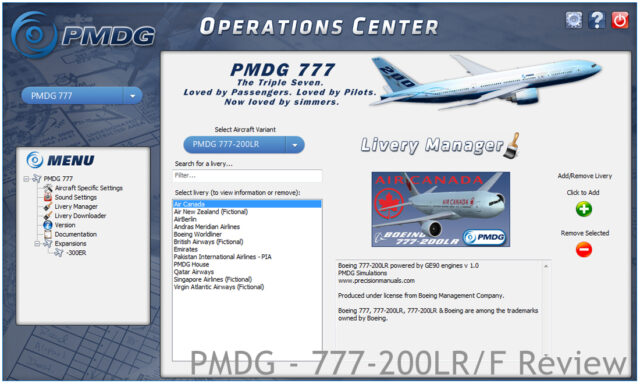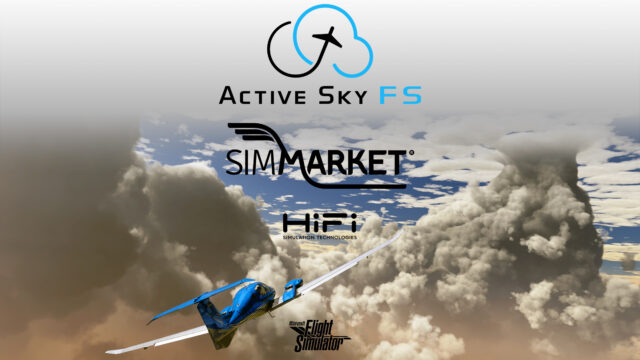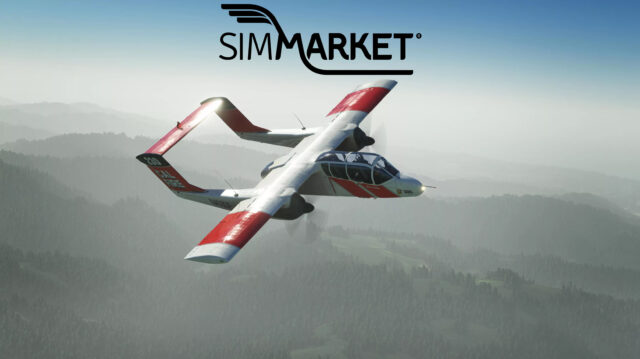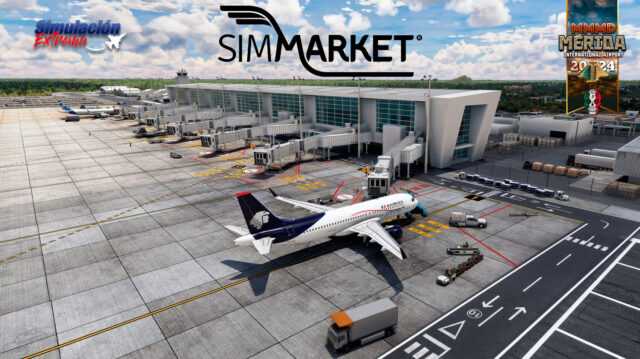 Waiting for Service Pack 1 for the PMDG 777-200LR/F took longer than anyone, including PMDG themselves, expected. But now that it’s finally there, and I’ve had a chance to test it, let’s take a new look at the product in question.
Waiting for Service Pack 1 for the PMDG 777-200LR/F took longer than anyone, including PMDG themselves, expected. But now that it’s finally there, and I’ve had a chance to test it, let’s take a new look at the product in question.
Before reading this review, I’d suggest to read my First Impressions Review if you haven’t already done so. Apart from a short summary, I’m not going to repeat what I wrote there unless I have something new to say about it or it is a feature I want to focus more attention on. That being said, this is too detailed a product to even attempt to cover everything. So the goal of this review in addition to the ‘First Impressions Review’ is to give you a good overview of the product and put the most striking features in the spotlight.
When you finish the review itself, keep on reading! Robert S. Randazzo, the CEO of PMDG, has taken some time out of his schedule to answer some questions. The answers he provided are very interesting, and are added to the bottom of this review in the form of a short interview for the readers enjoyment.

Summary of the First Impressions:
If you read the First Impressions which I published about 11 months ago, you’ll have noticed that I couldn’t stop using superlatives. I’ve been flying the PMDG 777 for close to a year now, and in general my first impressions haven’t changed. The installation is easy, and has been proven to work. The exterior model is smooth and very detailed and accurate. And it is covered in good textures, a level-up from the NGX. The Interior model is just as good, as are the textures here. It is a lot cleaner than the NGX on the inside, which seems to fit this interior very well. There are a lot of great animations to be found everywhere, although they are limited to the functional stuff in the virtual cockpit: switches, knobs, yokes etc… So no moving seats, swinging oxygen masks or books. Another amazing feature is the night lighting. Dimmable in the interior, lighting the environment in the exterior, and all very well balanced.
The sound set is also very good, both inside and out. It creates a very immersive atmosphere.
Alright, how’s that for quick and dirty? Let’s move on to stuff I haven’t written about before, shall we?

Systems:
I already wrote a bit about the systems in my first impressions review, but it is a section that most certainly deserves a little more attention in this review. Of course, this being PMDG, we were expecting very detailed systems modelling on this 777. But over the last year, it has been able to surprise me time and time again. There is always something new to learn, a new feature you haven’t used before, or a quirk of the real aircraft that rears its head in the simulated product when you least expect it. Hydraulics, electrics, pneumatics, air conditioning, fuel system, engines and more. It’s all there, with its respective synoptic pages. On top of this, the amount of detail to be found in the FMC/CDU implementation is staggering.

Talking about the CDU, this brings us to a new and improved feature in SP1 that adds a new dimension to flight sim: company datalink. In real life, this function is used to by the crew to download performance and weather data over a datalink, and have it (semi-) automatically entered into the relevant CDU pages. A lot of add-ons give you the ability to load routes created in other programs, and the initial release of the 777 already supported a weather uplink. But the systems has received both a makeover and an expansion in the service pack. Aside from the route and route winds, you can now also load performance data, descend forecast weather, the alternate airport list, and weather at the current 4 alternates. The makeover part of the update comes in the form of realistic uplink times, and all relevant CDU and EICAS messages. To get all of this to work, PMDG had to add a couple of new options, both general and airframe specific. For example, you can set the ‘Company Cost Index’, which the uplink feature will use in the “Perf init” page. As for the weather uplinks, the 777 obviously needs a way to know what weather there is at the relevant waypoint or airport. I’m not going to go into the technical explanation of all this. But the point is that the operation of this function depends on your weather engine. It should work with most weather engines out there. I’ve tested it with default FSX weather and Active Sky Next, and it worked seamlessly with both.

The most anticipated (and most previewed) feature that was added in the service pack, was a functioning weather radar. Based on the Collins WXR-2100 weather radar, it covers most of the major functions of the real unit. Manual or automatic tilt, gain adjustment, WX (weather) and WX-T (weather and turbulence) modes… It is a very nice feature, both in function and visually. But, as PMDG states in the manual, it’s considered an “in-progress” feature. It’s not perfect and not perfectly finished. At the moment, it doesn’t simulate ground returns, radar shadows, or loss of resolution over distance. All in all, despite not being 100% complete, I think it’s a very impressive feature. Because I’ve had it running, I had to (or was able to, depending on your point of view) to perform a go around to avoid windshear in Sint-Maarten and I’ve been able it to circumvent bad weather in controlled airspace on IVAO.
There is just one downside to the weather radar, but it’s a pretty big one. At the moment, it only works with Active Sky Next. This is good news for Active Sky Next users, but definitely not so good for anyone who uses any of the myriad of other weather engines available, including FSX default weather.

Flight dynamics and Fly-By-Wire:
While I could have put the section on fly-by-wire with the rest of the systems, I reckon the flight dynamics and fly-by-wire are so interconnected, it would make more sense to put them together here.
Obviously, I’ve never flown a real 777, and I never had the pleasure of flying a professional simulator either. Add to that the fact that I tend to prefer smaller tubeliners most of the time, and I can tell you, the PMDG 777 makes quite an impression. No matter what point in the flight, from parked on the ramp, through taxi, the actual flight and landing, the sheer size of the machine really hits home. People who often fly large aircraft will be more used to this, but if you make the transition from (for example) the PMDG 737NGX, it is something you will notice. That said, the flight dynamics feel really convincing. It’s a large aircraft, which you notice. You also notice that, like its real life counterpart, the 777-200LR or 777F is enormously overpowered. This actually makes sense: it’s build to be an extreme-range aircraft, and hence is powered to lift off comfortably at its maximum take-off weight. The result is that on shorter hops (short being a relative concept here), the 777-200LR/F can and will take off like a rocket. Engine derates and a precise rotation technique are your best friends here.

Once flying, the fly-by-wire system kicks in. This has received a huge makeover in the service pack. PMDG has explained why the system didn’t work as it should in the initial release. Apparently, they were fed some wrong information on which they based their simulation. Don’t get me wrong, the initial release was perfectly flyable. The difference being that it didn’t handle quite the same as the real aircraft. With the release of Service Pack 1, this has been rectified. And the result is impressive. What impresses me most is how smooth it all operates. In a combination of some old-fashioned fun, a genuine test, and a whole lot of silliness, I took the 777 down into the Grand Canyon. And I can tell you: it certainly was a lot of fun! But it also highlighted the handling of the 777: smooth, precise, accurate. The combination of flight dynamics and fly-by-wire that ships with the PMDG 777-200LR/F makes this product a joy to hand fly in any situation.

Frame rates, stability and smoothness:
I wrote in the first impressions review that I would get back on this. Now, first of all, the slightly ‘jerky’ animations. I’ve been looking into this, and the only reason it might appear jerky, is if you zoom in too much on large moving surfaces (cargo doors for example). For all practical zoom levels, everything is as smooth as it should be.
When talking about frame rates and smoothness of the simulation, I can say I have been pleasantly surprised. You shouldn’t expect to be able to run this product if you pc barely meets the minimum system requirements for FSX. But when compared to other large, high-detail add-ons, the PMDG 777 scores surprisingly well in both frame rates and smoothness. On my system it even does slightly better than the PMDG 737NGX in both respects.
On the topic of stability there are 2 aspects to consider. First there is virtual address space or VAS, which is the cause of the dreaded Out-of-memory (OOM) error in FSX. The second aspect is stability of the programming: does the product in itself cause hangs or crashes? On this latter aspect I can say I have never experienced any problem with the 777. No unexpected crashes, no freezes, no hangs. But please note that while I didn’t experience any of this, there are some reports on the PMDG forum of people experiencing unexpected pauses while running the 777. This is under examination by PMDG, and luckily is limited to a very small percentage of users.
The VAS aspect is a slightly different story. This is not a small Cessna you only fly locally. It’s a large, good looking and very detailed aircraft. This are 3 aspects that increase VAS-usage. Add to this the fact that long haul flights highlight some inherent FSX memory problems, and you can see there might be a problem here. Realising this, PMDG dedicated an entire chapter in the introduction manual to this subject, which is well worth the read. And in any respect, PMDG did a very good job of keeping the 777 efficient. I had some problems with OOM errors when I first got the 777, but just lowering my autogen density slider in FSX by just one step eliminated the problem for me, and I could hardly be happier with the performance and stability I get out of the 777. (Note, all screenshots shown are taken at the settings I actually use for my day to day flights, I didn’t up any sliders just for these shots.)
Ease-of-use:
I’ve been saying a lot on how detailed and precise this add-on is, with the risk of scaring off people who are not all that comfortable yet with high-level aircraft products. Therefore I want to talk a bit about the features and aspects of this product that improve the ergonomics and make it easier to use.
First of all there’s the design of the aircraft. This is something Boeing did of course, and PMDG recreated. The 777 is a highly automated aircraft, that performs a lot of the tasks a pilot has to do manually in another aircraft. Think of things like switching electric sources, the pressurization system, the electronic checklists… This greatly reduces workload, both in real life and in this simulation. As a result for us simulator pilots, is that the initial step to get to flying this aircraft is quite low. And as for realistically operating the aircraft: you get out of it what you put in. The more you study and practice, the better you get, as can be expected.

The second feature that affects ease-of-use is that, like the NGX before it, the 777 does not depend on external applications or popup menu’s that force you out of the simulator. Everything is done in the simulation. All menus and options are accessed through PMDG specific CDU menus. This includes stuff like opening doors, loading fuel and payload, accessing ground services, changing simulation options… Add to this that all options can be switched and changed in flight without it negatively affecting the flight in progress. This means that if you are curious about something while flying, you can just change it, and see for yourself without it interrupting your flight.

The final feature I want to mention here is the well-documented consistent use of mouse commands and mouse cursor shapes. No matter what switch you use, the shape the cursor takes when you hover over it, tells you how to activate that switch. I’ll be honest, I don’t know how to interpret these shapes from the top of my head. I’ve gotten so used to the consistent manner everything works that it’s become automatic. This is a great feature that makes using this add-on, especially in busy or high-pressure situations much more comfortable. You never run into the situation where (left) clicking one switch moves it down, while clicking the one next to it moves it up. More and more developers are learning how important it is to pay attention to this aspect of their product, but it still surprises me that not everybody has figured this out. PMDG has done so a long time ago.

Extras: Operations Center and repaint kit:
In respect to the Operations Center, I want to rectify a mistake I made in the first impressions review. At the moment, the OC does not include and update feature for the products it supports. It didn’t when it was first released, and it doesn’t now either. It is a possibility PMDG is working on, but it’s not anticipated to be rolled out for a while. The Operations Center does include the possibility to update itself, and can check the versions of your installed PMDG add-ons (at least the supported ones) and direct you to the update if needed.
With the release of SP1, and the associated update to the Operations Center, the livery download feature was extended to the Jetstream 41 and 737 NGX products. This makes this utility even more useful than before for people who have more than just the 777 from PMDG installed. Just to clarify again, the Operations Center does not work with PMDG products older than the J41 (which would be the MD-11 and current 747 in FSX). And at the moment, it’s only included in the 777 installation, there is no download available for J41 or NGX users who don’t own the 777. It has been hinted at in the forums (by PMDG support personnel and beta testers) that this would be a possibility in the future, but it’s not there just yet. And please note ‘hinted’, ‘possibility’ and ‘future’ in the sentence above.

Also note that there is a repaint kit you can download for free from the PMDG website. It’s not a small file, coming in over 400MB for each of the available variants. But it’s a very detailed and well structured repaint kit, with in depth documentation provided. If you know how to repaint, and your PC can handle the large Photoshop files, you’re all set to create some stunning new paints.
Conclusion:
While the initial release of the Precision Manuals Development Group 777-200LR/F resulted in a perfectly usable product that I liked very much, it did have a few aspects that required fixing or just weren’t as polished as they could be. With the long awaited Service Pack 1, PMDG went above and beyond. Not only did they fix the known problems, they included a whole lot of new functionality in the aircraft without charging us extra. Something we as users can only celebrate. The end result is an add-on that once again sets a new benchmark for modern airliner products for Microsoft Flight Simulator X. The biggest downside is still the price, which hasn’t changed since my first impressions review. But if you like long haul, glass cockpit airliners, I can honestly tell you it’s worth it.
Not much changed since the first impressions:
- Very high quality visuals
- Great sound set
- Detailed yet easy to use systems
- Operations Center centralises all out-of-sim functions, and now fully covers the J41 and NGX.
- Weather radar!
Don’t like:
- Although I think the 777 is worth it, I still keep the steep $89.99 price in my ‘don’t like’ list.
- The weather radar only works with Active Sky Next. Only a downside if you don’t own ASN, but given the many choices people have in weather engines, this will be quite a lot of people.
Interview with Robert S. Randazzo, CEO of Precision Manuals Development Group:
Lars Domen: Mr. Randazzo, thank you very much for taking some time out of your schedule to answer these questions. My first question is the following:
Creating products like the 737NGX or the 777X takes more than just one person. Can you introduce us to the team at PMDG, yourself included?
Robert S. Randazzo: Since 1998 when work began on our first software product, PMDG has been a global, diverse team in every sense of the word. On the product development team for the NGX and 777 we have a code development team comprised of Dr. Evangelos Vaos, Michael Frantzeskakis, Alexei Bashkatov and me. The modeling and artwork is handled by Vin Scimone and Jason Brown who develop our cockpit and external models respectively. Sound processing and development is handled by Armen Cholakian with quite a bit of recording help by Ryan Maziars (who many will recognize from our support team with Paul Gollnick). Livery painting is done primarily by Pete Sterling with a bit of contribution by other members of the team, and then we have a couple of “Sweepers” who jump in to a broad range of tasks to lend support when needed, in the form of Chris Powell, Henning van Rensburg and Matt Kaprocki.
It is a simplification for me to lump members of the team together into general classifications like this because it doesn’t describe the entire team, nor does it do justice to how much interdisciplinary work and cooperation takes place. We span 11 time zones and six countries and we are developing on three different simulation platforms and three operating systems as of today. It simply isn’t enough to be a good programmer or a good model maker to succeed at PMDG. We thrive with developers who are inquisitive, inventive and curious and this is a unique trait that covers the members of our team from development all the way to support.
LD: What are you personally most proud of, in regards to your, and your team’s, work in the flight simulation business?
RSR: We are most proud of our total product quality. So many developers throughout the gaming/development industry have moved away from product quality as a core value and instead focus on marketing deadlines or development speed. At PMDG, we focus on providing a tremendous depth of simulation to our customers combined with high overall product quality. When someone says that they are comfortable purchasing our products on release day because they know the product will be market-ready, and complete, this tells us that we are on the correct path.
LD: In relation to developing a detailed product as the NGX or the 777X, what do you experience as being the biggest hurdle or the hardest part?
RSR: We have a saying internally at PMDG: “Why use a small shovel when you can dig so much deeper with a big shovel?” Our development process takes time, and this is because we really dig deeply into the detail of how airliners are constructed. We don’t just turn on a pretty primary flight display graphic, we model the symbol generator, the inertial systems and air data units that provide the data for display, and the electrical systems that power them. When you develop systems to this level of detail, sometimes it is hard to know when to stop…
LD: As the CEO of an influential development group, how do you see the future of entertainment flight simulation? And how do you see the future of PMDG in that respect?
RSR: I think simming as a hobby is in great shape and has a vibrant future. There has been quite a bit of hyperventilation over the eventual demise of FSX, but I do not see Microsoft’s exit from the game as a negative development for the community. PMDG was involved in an effort to secure the rights to the Flight Simulator franchise, but this effort was not successful and it is our hope that the winner of that effort will recognize the importance of providing access to the “new” Flight Simulator platform for external developers. Examining their existing business model provides some clues, however, so PMDG is beginning the process of diversifying our development across multiple simulation platforms in order that we can continue to provide the types of quality products our customers have come to expect for their simming experience.
Within the next six months or so we will be releasing products into three simulation platforms (a first for PMDG!) and also offering products on multiple operating systems for the first time since 1999.
All in all, very exciting developments for all of us here at PMDG and for our customers who will now have a broader range of choices when it comes to enjoying their PMDG products.
LD: Is there anything you are willing to tell us about products in the PMDG pipeline? Anything we should be looking out for, surprises we can expect?
RSR: We are notoriously tight-lipped about our development work because we sometimes need the flexibility to shift development priorities around in order to keep our core product development moving forward smoothly. I can tell you that we are within weeks of going into beta testing with our first P3D release and that we are a few months away from beta testing our first X-plane release. The X-plane release will be a surprise because it is the first time we will have developed a product from the ground up with the intent to release it in more than one simulation platform- X-plane and FSX in this case.
LD: I want to thank Robert Randazzo again for answering these questions, and lifting a bit of the veil that add-on development more often than not is for the regular user/customer. I also want to thank PMDG for developing these outstanding products for us to enjoy, and for giving me the chance to test them.
Useful links:
Test system:
Intel Core i5-2500K @ 4×3.3GHz (stock speed)
8GB DDR3 RAM
MSI N560GTX-Ti Twin Frozr II
Windows 7 64 bit
FSX Deluxe + Acceleration















![[Video🎬] New Trailer 4K for Turkish Airports MSFS by SceneryTR Design – Istanbul – Ankara Trabzon by SIMMARKET](https://www.simflight.com/wp-content/uploads/2024/04/SceneryTR_thumb.jpg)
0 Responses
Thx for the article and interview!